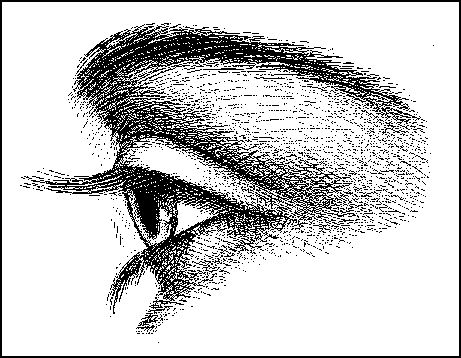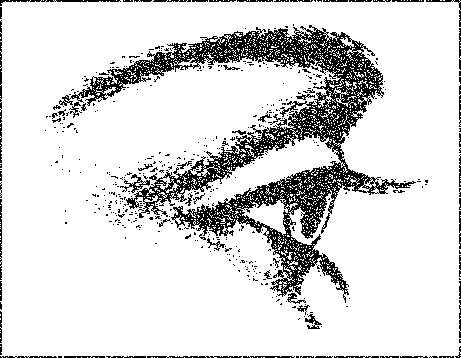Cataract
Blues

My cataract operation, except for a few glitches, was a lead-pipe cinch. Like being hit with a lead-pipe. In the head.
First of all, they don't tell you what happens when you get the infection, the one they call edema. It happens in 10% of the cases, mumbled my doctor, reluctantly, after I pressed him.
It happened to me. Which meant that for ten days after the operation, I could barely see out of my new plastic eye. For someone who reads and writes ten hours a day, that's life-threatening stuff.
They also don't tell you about:
- The acid-powered drops you are forced to squirt in the offending eye, four times a day, for three weeks or so, before and after the operation. If you don't think that's such a bother, think of having to lie back and apply three or four different industrial-strength chemical solvents to your eye at various inconvenient times of the day. They all carry those modern comforting medical names that sound like exotic ports-of-call --- Acular, Zymar, Forte. The latter, a white gook called "Pred Forte," named no doubt after a chemist named Phred Forte, looks deliciously like old pus. After the application, as it dripped slowly from my tortured orb, it reminded my friends of the more ghastly beggars of Calcutta.
- The sheer, compelling disruption of it all. In the old days, with my old bad eyes, I would be reading and writing and reading and writing. Now with the discrepancy between the "good" new eye and my old "bad" eye, reading is a royal pain. I am constantly taking on and off my new glasses, pulling the book up to my face, then pushing it away, trying to get the fucking words in focus. Which, after all this travail, leads one to the sad knowledge that
- No matter how bad the eyes were before all this, God's lens probably still had a bit of resiliency in it, making it possible to focus, no matter how slightly. This new plastic gizmo has no flexibility whatsoever. The focus in the new Robotic eye is exactly twenty inches from my nose. (The new lens was supposed to make it easier to see my computer.) What I didn't know then, what I do know now is that this fixed twenty-inch focus is just that: fixed. At fifteen inches, or twenty-five, vision in the new eye is a big dumb blur.
- Floaters. You remember floaters, those little spots that ramble around your eyes until you blink them away. They are now worse, by a factor of ten. Why? These are residuals, bits of gel bobbing around inside my eyeball. With my sharper vision, they come into perfect focus whenever I rest my eye on anything for a few seconds --- a book, a flower, the cars ahead of me, my own image in the mirror. They turn whatever it is that I am looking at into a blur, and they only disappear when I shake it up, like one of those Santa Claus globes with fake snow that we used to play with as kids.
- Dr. Zorrillo's merry band also didn't bother to inform me (and now I know, because I looked it up, finally) that the chance of detached retina occurring as I age is now far higher after the cataract operation.* Leading us inevitably to the old wheeze, "There ain't no such thing as a free lunch."
- They also didn't tell me, nor did anyone else, about The Martian Ray. When I drive at night there appears a long bright sliver of a ray running through the lights of every approaching car. It is neither vertical nor horizontal, but, rather, slants across from upper left to lower right ... at an approximate 120-degree angle. It looks like one of those satellite shots of Saturn, head-on to the rings, or maybe a direct shot of the sun in eclipse, with a bright, very bright line leaking off above and below.
 This new Ray is as bright as the headlights it is mirroring, so it blots out everything else on the road, including animals, cars and people. As a result, I have reluctantly given up one of my favorite nighttime sports --- driving.**
This new Ray is as bright as the headlights it is mirroring, so it blots out everything else on the road, including animals, cars and people. As a result, I have reluctantly given up one of my favorite nighttime sports --- driving.**
Other surprises? If you and I are eating a romantic meal by romantic candlelight in a darkened restaurant, I can't see the mashed potatoes and roast beef, much less my plate, forks, knives, and the glass of wine. Even you, my love, are blotted out. The Long Bright Ray reflecting off the candle-light blasts everything out of sight.
I lambasted myself vigorously because I did no Google search beforehand on "cataracts" or "cataract operations." I finally gave it a try after the operation and found that it would have made no difference whatsoever. It's all happy faces out there in Post-Op Eyeland.
iEnhance.com tells us we should "Learn more about Cataract Surgery and how it can make you look and feel good." The American Academy of Ophthalmology (AAO) wonders, "What is a cataract?" and then immediately tells us: "A cataract is a clouding of the normally clear lens of the eye. It can be compared to a window that is frosted or yellowed."
- Surgical removal of the cataract and replacement of the cloudy lens with a clear, synthetic, substitute lens is a treatment that results in highly satisfactory results.
Further down the Google page, the omnipresent Dr. Koop offers to give us information "about the prognosis, risks, and recovery," of the operation, but damned if I could find any "risks" noted in his overview.
"The Aging Eye Times" compares the eye to a fragrant melon,
-
The cataract does not have to become 'ripe' to be ready for surgery.
And Kidshealth.org suggests: "Even the juveniles ought to know about the procedure:"
-
Did you find out that your grandparent has cataracts? Do you know what they
are? Read our kids [sic] article to find out all about cataracts.
 It is all peaches and cream there in Google-eyeville, at least for the first 300 entries. I had to get well down through page fifteen, trailing through cheery assurances, lists of veterinarians' procedures for cataracts in aged dogs, and no few hikes along "Cataract Canyon" before I arrived at entry #323. MedHelp International (http://www.medhelp.org/index.htm) was the first place I found with any questions about the efficacy (or lack thereof) of this surgery. One correspondent wrote,
It is all peaches and cream there in Google-eyeville, at least for the first 300 entries. I had to get well down through page fifteen, trailing through cheery assurances, lists of veterinarians' procedures for cataracts in aged dogs, and no few hikes along "Cataract Canyon" before I arrived at entry #323. MedHelp International (http://www.medhelp.org/index.htm) was the first place I found with any questions about the efficacy (or lack thereof) of this surgery. One correspondent wrote,
- I am frustrated as to why my vision is worse than it was before the surgery. The present doctor wants to send me to another specialist.... In my work I sometimes have to transport other people and I am afraid of that. It has affected my driving confidence. My eyes are exhausted all of the time. Am I going to be like this from this point on?
Another wrote,
- Five weeks ago, I had cataract surgery on my left eye. Since that surgery whenever I am next to a window or any kind of light, I see a half circle of light and rays of light reflected off of what appears to be the edge of the lens in my eye. Also, at night I experience a lot of glare.... I am 53 years old and do need cataract surgery on my right eye but am very concerned about the same thing happening to my second eye. I feel this would be very difficult to cope with.
The only light note I found in Google came from World Wide Words, which reports,
- The Greek word [kataraktes] became applied to a number of things that rush down, including a swooping bird and a waterfall. It was transferred into Latin in the form cataracta and in that language could refer to a waterfall, [or] a flood-gate or a portcullis (the vertical grated gate to a castle that ran in grooves in the wall and which could be dropped very rapidly to bar entrance) ....
From about the middle of the sixteenth century, cataract also began to be applied to the medical condition in which the lens of the eye goes progressively opaque. It seems that doctors were using the word as a simile for something that stopped light entering the eye. An older expression for the same condition was web in the eye, so the name was most likely derived from the barred structure of the portcullis or window grating, rather than as a physical barrier.
- *This came to pass eighteen months after my cataract operation. I woke up one lovely morning in spring and a black curtain had fallen down across the field of vision --- in my case, from the upper right.
The world is thus divided into the seen and the black. Between them is a terrifyingly wobbly border that shifts every time you move your eye.
The operation to fix a detatched retina is invasive, takes several hours, and includes things, I don't want to tell you more, being stuck directly into the eyeball. You are then sent home, told that you eye will be stronger than before (in other words, the retina has been welded back in place).
This, is true. The retina in my right eye now knows where it belongs, and stays there, without protest.
**The Ray was cured a year later by Dr. Zorillo zapping somewhere around or under the new lens with a lasar "to get the wrinkles out," as he called it. The Ray did go away, mostly. The three-minute procedure cost Medicare another $1,000 and me another $200.